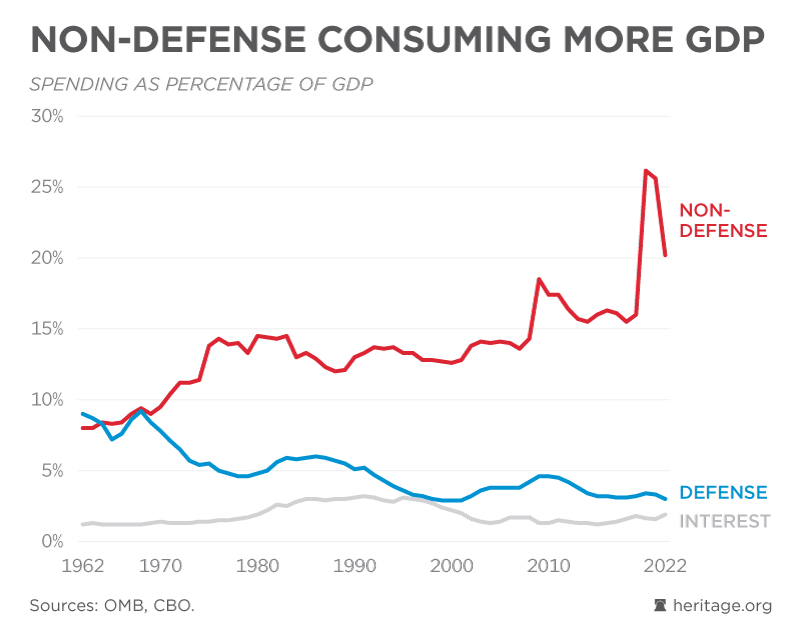The recently released Biden administration budget for 2024 was layered with problems. It doesn’t take the surging size of the national debt seriously; it views shaking down taxpayers as the solution to fiscal problems; it would hand massive raises to federal bureaucrats; and it offers bad medicine for Medicare while allowing Social Security to go bankrupt.
Yet perhaps the central flaw with the plan is that it proposes to further expand the non-defense roles of the federal government, as though Washington doesn’t have control over enough of Americans’ day-to-day lives.
Reality check: Non-defense spending has exploded, fueling unaffordable federal deficits. Since spending on major benefit programs like Social Security and Medicare is set to automatically grow every year, Congress must act quickly to bring this spending down to earth—and absolutely must avoid President Joe Biden’s approach of feeding the federal leviathan even more.
The federal government had relatively little involvement in the domestic economy until the 20th century. As the century progressed, national defense—which ought to be the primary responsibility of the national government—shifted from a dominant part of the federal government to a fractional one.
In contrast, non-defense spending has been on a steady upward trajectory. President Lyndon Johnson’s “Great Society” agenda, which created Medicare, Medicaid, and new welfare programs, put domestic spending on steroids.
While big spikes in domestic spending eventually recede, they never come back down to the levels they were before the spikes. The long-term trend is clear: More and more of America’s economic output is devoted to the federal government’s domestic agencies and programs.
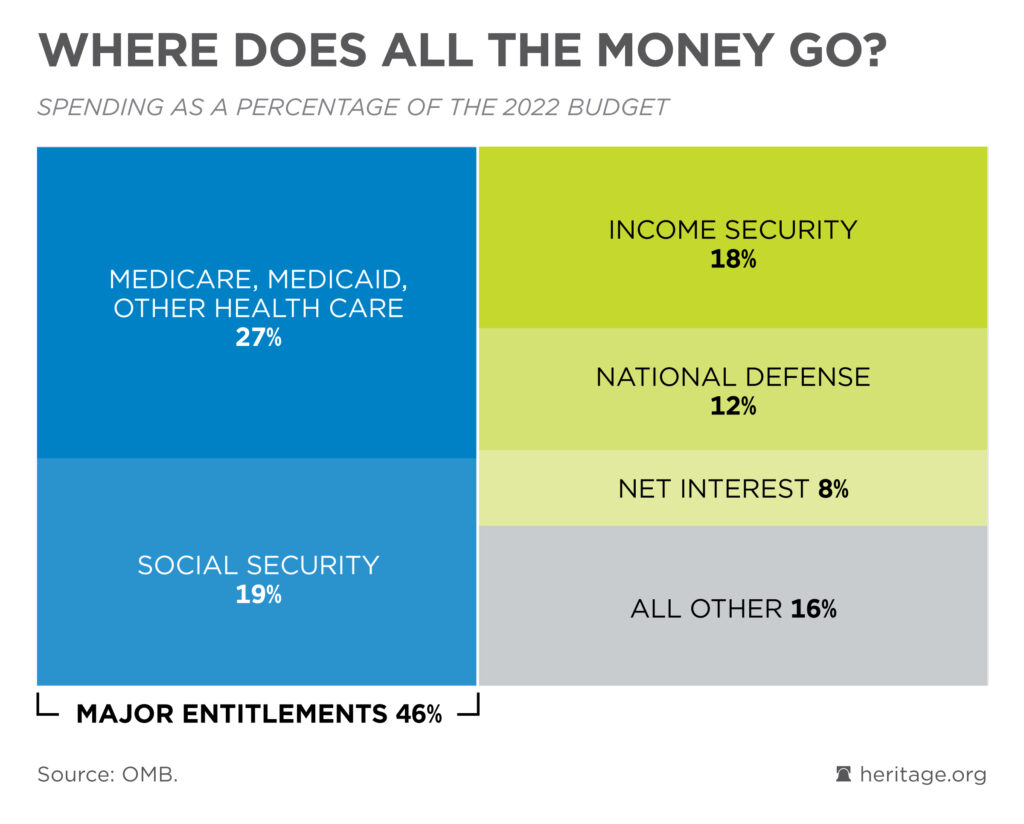
A snapshot of the 2022 federal budget helps to clarify where things are today. Health care (not counting the Veterans Administration) and Social Security account for 46% of total federal spending, and almost exactly half of all spending when one excludes interest payments on the debt.
Considering that the “income security” and “other” categories in the chart above include welfare, “green” energy subsidies, corporate handouts, and legions of IRS agents, we can see just how far the federal government has strayed from its core responsibilities.
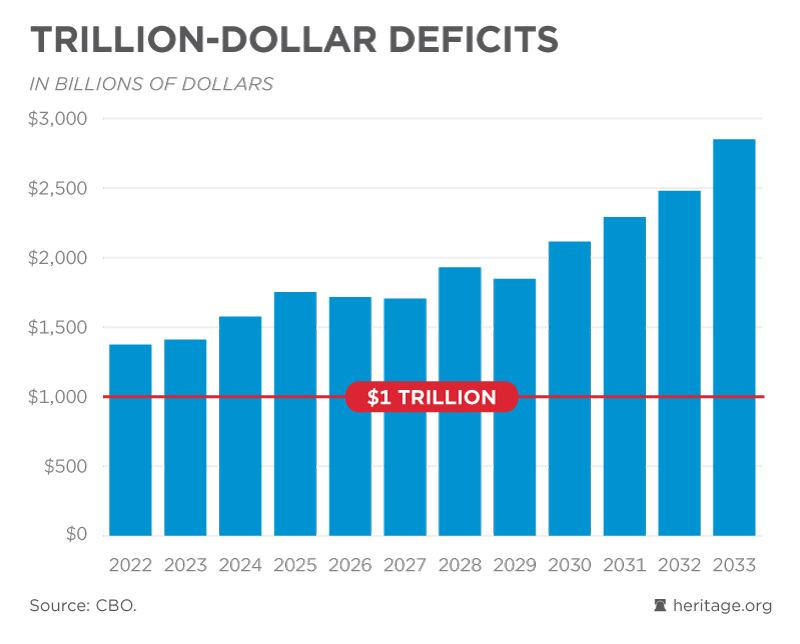
As federal spending on domestic programs continues to grow faster than the economy, it also grows faster than tax revenues—despite record-breaking tax hauls in recent years. The result: Budget deficits are expected to rise rapidly over the next decade—something that Biden has made worse. Deficits even rise to $2 trillion in the last year of Biden’s budget, which means he doesn’t see a way around that dismal future.
Note that the chart above assumes no new pandemics or other calamities that would disrupt the economy and damage federal finances. If our shaky economy dips into a recession, deficits will climb even higher.
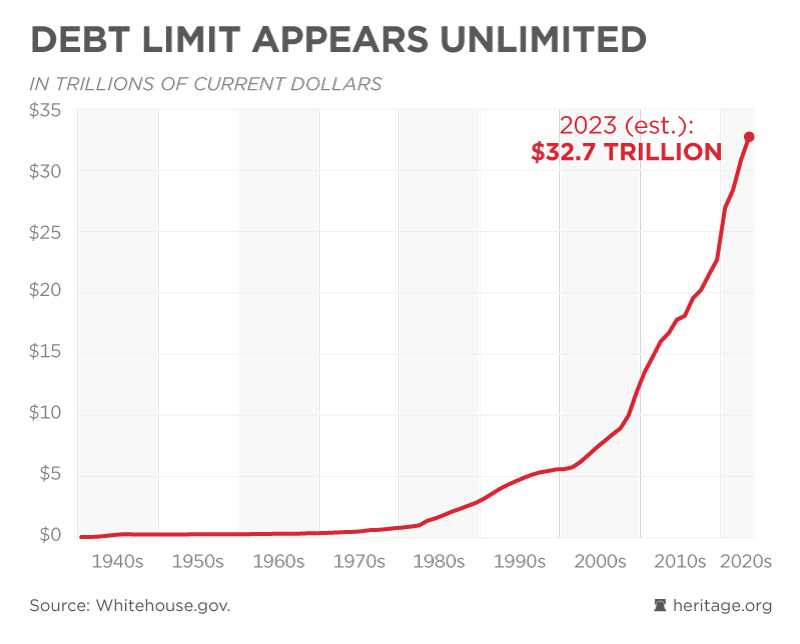
Those large deficits keep adding to the enormous federal debt, which is why the government has bumped up against the debt limit ceiling. Congress will need to pass legislation to increase the debt ceiling this year, providing an opportunity for fiscal conservatives to put forward badly needed spending reforms as part of a legislative deal.
Although we can expect swampy special interests to throw a fit over any proposal that shrinks government goodies, the American public understands that Uncle Sam needs to go on a diet.
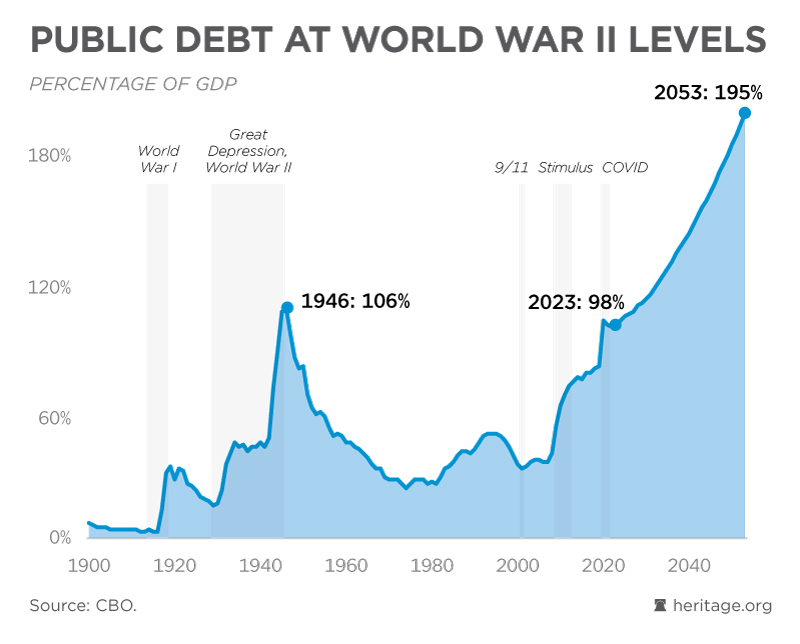
While the national debt is skyrocketing in absolute terms, it’s also growing at a concerning rate when compared to the size of the economy. The “publicly held” measure of government debt is now at a level not seen since just after World War II. Incredibly, this inflation-adjusted measure of debt is on pace to double over the next 30 years.
We’ve seen the havoc that unrestrained federal spending and high deficits can cause to the economy, most notably in the form of massive inflation. More debt and more waves of unsustainable spending will make the economy increasingly vulnerable to destructive cycles of high inflation and high interest rates.
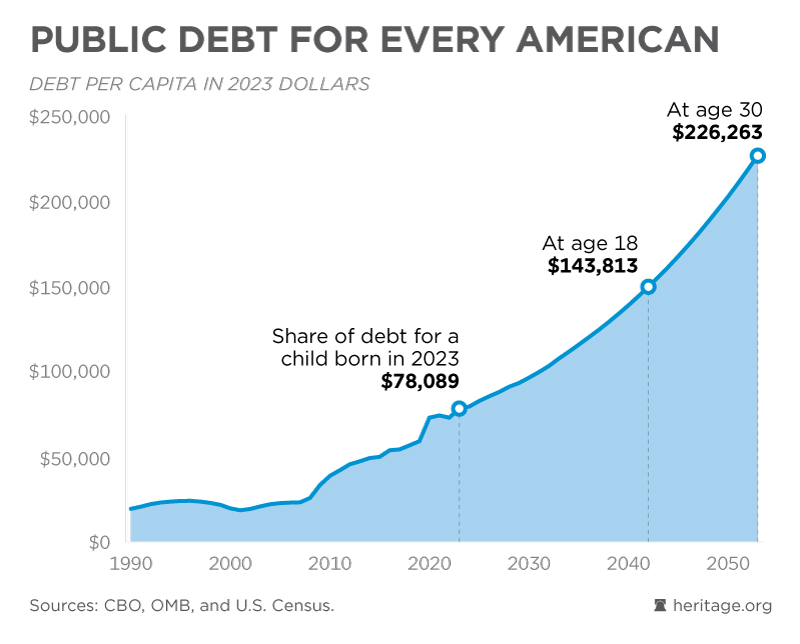
Numbers surrounding the federal budget—most of which are counted in billions or trillions—are nearly impossible for the human brain to fully comprehend. Breaking things down to an individual or household level makes it possible to grasp how bad federal finances have become.
To illustrate, a child born today enters the world with a $78,089 share of the federal debt. By age 18, when he or she will finally have a chance to enter the democratic process and vote for people to fix it, the inflation-adjusted debt share will be over $143,000.
Beyond the many economic problems that flow from excessive federal deficit spending, we must not forget the moral dimension. Young Americans having a $143,000 share of debt upon entering adulthood is beyond merely “unfair;” it’s an injustice, and the only way the government will be able to pay that debt is by dramatically cutting services and benefits programs and by raising taxes on all income levels.
When members of Congress and lobbyists moan and gnash their teeth over the prospect of any pet programs getting a haircut, remember that they’re perfectly content to pass the bill to the next generation—your kids and grandkids—and even yet unborn generations.
Members from both parties bear responsibility for years of irresponsible governance, and it’s their duty to make some tough decisions for the sake of protecting America’s future.
Legislators can’t claim to be ignorant of these fiscal realities or completely unaware of possible solutions. The Heritage Foundation’s Budget Blueprint provides hundreds of ideas to eliminate, cut, and reform federal programs, even to the point of making room for pro-growth tax cuts to put more money back into the pockets of the average American.
Given who currently controls the White House and the Senate, it’s very unlikely that all (or even most) of the Heritage budget plan will pass this Congress. However, if legislators are willing to address at least some of the many areas of federal dysfunction, that would be a long-overdue step in the right direction.
Have an opinion about this article? To sound off, please email letters@DailySignal.com, and we’ll consider publishing your edited remarks in our regular “We Hear You” feature. Remember to include the URL or headline of the article plus your name and town and/or state.
The post 6 Charts Show Why Washington Must Cut Spending ASAP appeared first on The Daily Signal.
- The Sneaky Way Deep-State Bureaucrats Advocated Censorship of Americans in 2020 - November 13, 2023
- There Is No ‘Second America’ if This One Fails - November 13, 2023
- ‘Zero Appetite’ in Israel for Cease-Fire With Hamas, Embassy Official Says - November 13, 2023
JOIN US @NewRightNetwork on our Telegram, Twitter, Facebook Page and Groups, and other social media for instant news updates!
New Right Network depends on your support as a patriot-ran American news network. Donate now

